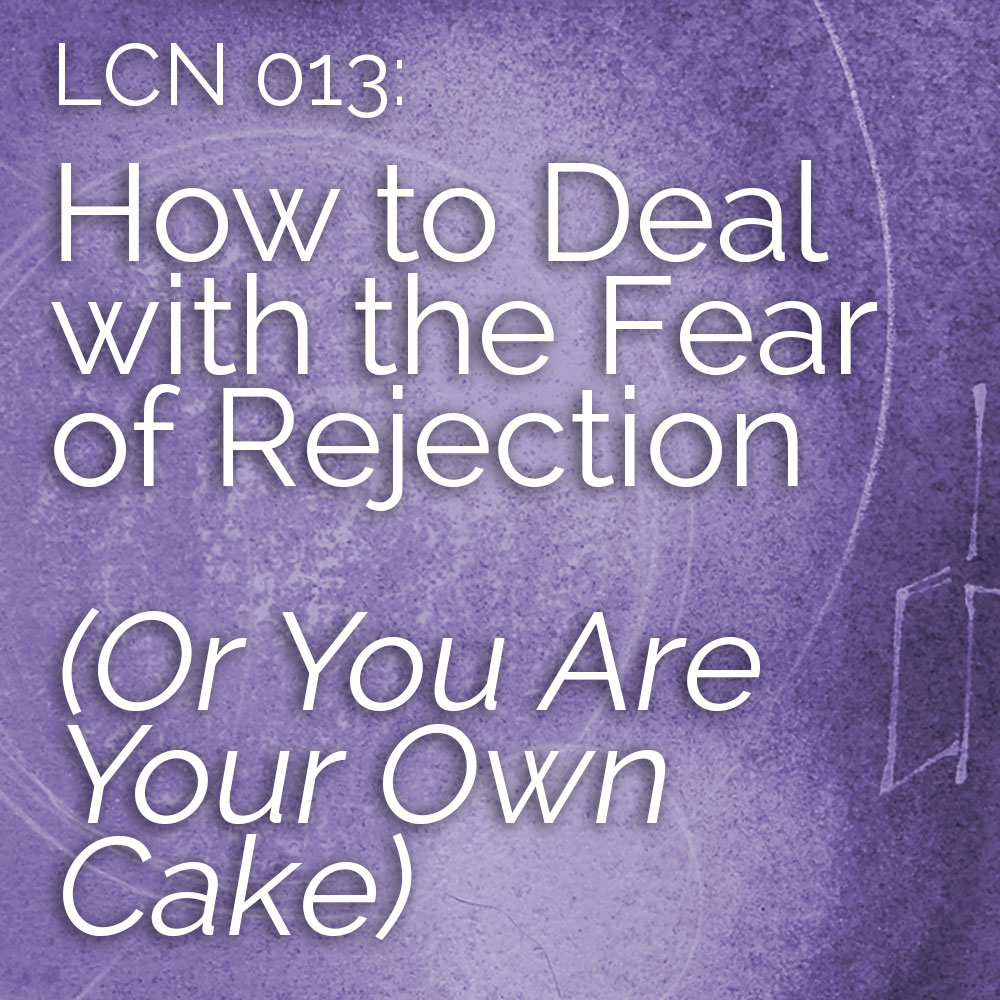
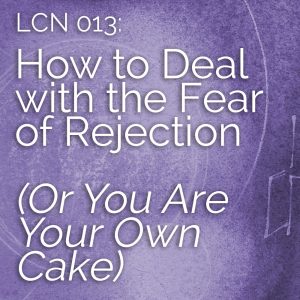 I get asked a lot about how to deal with the fear of rejection. How do we keep putting ourselves out there when we know we’re subjecting ourselves to potential pain?
I get asked a lot about how to deal with the fear of rejection. How do we keep putting ourselves out there when we know we’re subjecting ourselves to potential pain?
In this episode I talk about the importance of detaching from the need for external validation, why YOU are your own cake, and the 4 questions to ask yourself when deciding whether to take a risk.
1
Several months ago I took a risk and submitted a couple of proposals to present at a conference I’m going to in September. I put a lot of effort into determining my strongest ideas and writing compelling descriptions. I knew the competition would be stiff, but I also knew my proposals were good ones.
I filled out all the forms, uploaded all the files, and clicked submit. Then I forgot about it.
Time passed. It might have been weeks, it might have been months — I don’t remember. But one day I got an email in my inbox with the results.
My proposals were not accepted this year.
And you know what my reaction was? “Oh, well.”
Sure, I was disappointed, and yes, I was a bit envious of everyone who got chosen, but I went on with my day, and life was good.
2
Contrast this with several years ago. Cue the tape reel all the way back to 1999.
I was in the middle of my divorce, staying in Berkeley for 5 days for a long calligraphy workshop. One day in class I overheard people talking about teaching at the following year’s conference, which was being hosted by my home guild, the Friends of Calligraphy.
The teachers and classes, I realized, had already all been selected, drawn from a pool of “by invitation only” proposals, and I hadn’t even been invited to apply.
I hadn’t even had the opportunity to have a proposal rejected. My home guild had completely passed me over — I felt like a non-entity, rejected even from the chance for rejection.
It was devastating. I felt utterly flattened.
In this second story (which took place long before the first story), there’s more going on than just simple rejection, of course. I felt completely dismissed and discounted, totally invisible to a group of people who knew me, a group where I wanted desperately to belong.
So naturally it was more painful than if I’d been invited to apply and then had my proposal rejected.
But still, I remember where my head was back then. Being accepted felt like being anointed as “enough,” as “worthy,” and being rejected felt like the opposite.
The more recent rejection, though, didn’t carry such weight. I felt a mild sting of disappointment, but it didn’t cut me to the core.
What changed?
3
People ask me all the time about how to deal with rejection. We are so scared of the pain that it often feels easier to just not even try.
I’ve been there. I remember countless times receiving a call for entry for some art show in the mail (this is before the internet was really a thing), and I’d read the specs and think about making something to submit… but then I’d choke.
Hey, I still do this! I have some big asks that I haven’t gotten around to making yet, because I want a “yes” so badly, and I want to craft my proposals to be as strong as possible. So yeah, I still stall.
But here’s the difference between now and 1999:
Eight, Ten, fifteen years ago, my entire value as a person felt wrapped up in being accepted.
Getting accepted to teach at the next year’s international calligraphy conference…
Having my work published in a prestigious journal…
Being invited to teach for groups around the country…
Having my art accepted in an exhibit…
Making the audition for the Vocal Intensive at Jazz Camp West…
These things used to feel like critical markers of enoughness. Not being accepted felt like an indicator that I had no worth.
My life was an endless pursuit of external validation.
My inner sense that I was not enough put me in a state of frozen need, and when your need is frozen, no amount of validation will ever fill that black hole.
4
I remember when I finally had some of my art accepted for publication in Letter Arts Review.
This had been an aching goal of mine since I started doing calligraphy back in 1995. Letter Arts Review showcased all the best calligraphers, so if they accepted me, my reasoning went, it will mean I’ve made it.
My big dream was to have my art published on the cover, but even being published in the inside pages felt like it would prove my worthiness.
But when some of my ketubot were printed in a special wedding edition back in (???), do you think I felt validated?
Just the opposite! In fact, instead of seeing my acceptance of proof of my worthiness, I saw it as proof that this issue of LAR wasn’t a “real” issue.
Looking through the lenses of my frozen need glasses, I was only published in the wedding edition, so it didn’t really count.
If LAR had put my work on the cover, I’m sure I would have found some rationalization for why that wasn’t proof of my worthiness either.
This is how frozen needs work. They are unfillable.
A frozen need is an insatiable hunger. The only way to end the hunger is to stop seeking an outside solution and start looking inward.
The beautiful thing is that when we do this, things do shift.
Over the years, as I grew more into myself, I began, little by little, to understand that my worth does not lie in external validation by some gatekeeper or authority figure, or anyone other than me.
My value lies in simply being me.
The real gold I have to share comes from occupying my skin fully and bringing my full self to the table.
The same is true for you.
5
Sometimes the best validation is just knowing that other people have the same flaws that you do.
Back when calligraphy was my main creative focus, I remember feeling envious of another teacher who taught some of the similar subjects that my classes covered, but who was accepted to teach at the conferences more than I was. She’d been around a lot longer, and had more cachet in the calligraphy world than I did, and it burned me up (because, again, that external validation felt like the thing I needed to be enough, to be worthy.)
One year this teacher and I ended up seated next to each other on the bus back to the airport after the conference (where she had been teaching, and I had not). Even though I no longer felt unworthy when my conference proposals weren’t accepted, my envy still made me want to hate her.
But our conversation softened my heart.
I asked her what she loved about teaching, expecting some ego-related answer. Instead, she spoke poetically about the joy of walking people into dark rooms and switching on the light for them.
Then she confessed that it had not always been this way.
Years before it had been about ego for her (just the way it used to be for me). The actual teaching had been secondary. It was the prestige and acceptance that she used to seek out.
Then something had shifted in her life, just as it shifted in mine.
We get to change. Isn’t this a beautiful thing?
6
I became aware of the progress I’d made in letting the air out of my ego, and melting my frozen need for external approval, when I received an email out of the blue from the editor of Letter Arts Review, asking if they could use some of my art on the cover.
My response?
A decade before it would have been, “Oh, my god! I’ve finally made it!!!!” Followed immediately by some rationalization for why getting on the cover of LAR was not, in fact, proof of my worthiness, and the appearance of some new, out-of-reach goal that would take its place.
Instead, I remember thinking, “Oh, huh. That’s nice.”
Followed immediately by a golden glow of noticing that acceptance or rejection didn’t control my sense of worth anymore.
What a relief!
I’ve been rejected and accepted dozens of times since then, for all sorts of things. Yes, sometimes I’m disappointed, and yes it stings. And yes, I’m delighted when I get accepted, but it’s the frosting, not the cake.
I now know that I am my own cake.
The lesson? Do it for you. Because it feeds you. Because you love it, or because it’s important to you.
Everything else is frosting.
7
Even when you are your own cake, it still hurts to be rejected. It feels so much safer to just not put ourselves out there.
When we just think about avoiding the pain of rejection, however, we’re not taking into consideration the other side of the equation.
We know rejection will hurt. But what about the pain of not trying?
We tend not to think about this side of things, because it’s not so immediate.
When you get rejected, it’s an immediate, sharp sting. When you don’t try, the pain is the ache of regret. It starts out dull (combined with a sense of relief at avoiding the sting of rejection!), but over time it can grow to become all-encompassing.
That’s the full equation: sharp pain now, or growing pain over time.
If you want to weigh the risks of a possible rejection, the only way to do it justice is to also consider what life would look like if you never even try.
8
This is exactly what I did at age 19, when I decided to fly to New York to audition for the Dance Division at Juilliard.
I’d just spent a year at UC Berkeley, dancing a mere 2-3 hours a day (which at the time felt like a pittance), and my dance teacher had pulled me aside one day early in the summer to encourage me to audition for Juilliard instead of going back to Cal, where (as he put it) my “talents were being wasted.”
The prospect of the audition, and of moving to New York, felt enormous and unknown and terrifying.
But what clinched the deal for me was driving home that evening.
Tears dripped down my cheeks as I gripped the wheel of my family’s orange VW bus. What if I flew out there and didn’t get in?
Then I asked myself the harder question: How would I feel if I never tried?
I didn’t want to turn 40 (which felt like such an ancient age back then!) and wonder what might have been.
9
Looking at the question from the other side was a way of reframing it for myself. You can do the same thing whenever you’re facing a potential rejection.
Here are the reframing questions to ask, to help you lean into the fear and and avoid the pain of regret.
1. Ask yourself, “What if the worst happens?”
Really, what if? What would truly happen? Write it out. Take that storyline all the way to the end and make a really vivid picture of it.
If I audition for the Vocal Intensive at Jazz Camp West and don’t get accepted, I’ll feel a bit hurt, but I’ll go on to take other classes and will have a wonderful week.
2. Ask yourself, “How will I recover?”
Get very specific about this part too. Write down the picture. The reality is that almost everything is recoverable.
The cool thing, too, is that when the worst happens, it has a way of stripping away fear, because you’re already at the bottom. The only way to go is up!
3. Ask yourself, “What if I do nothing?”
At first this may seem like the easier option, but it could turn your life into an agony over time.
4. Ask yourself, “What if I succeed?”
What will it look like? What will it feel like? What does your day look like if you try, and your dream comes true?
After you take the time to really answer these questions for yourself, break your ideal vision into the smallest, tiniest actions you can take today that inspire joy. And replay the storyline over and over for yourself anytime you falter.
10
In summary, yes, rejection hurts, but when you stop seeking outside of yourself for proof of your enoughness, the frozen needs start to melt.
You get to grow and change, and you are your own cake. Keep aiming at your own delight, not at outside solutions. External validation is just frosting — sweet, but little substance.
And when debating about whether to take a scary risk, before making a decision, make sure to consider the full equation by asking the four reframing questions — What if the worst happens? How will I recover if it does? What if I do nothing? What if I succeed?
That is how you deal with the fear of rejection.
Reminder: Contest!
Don’t forget! To celebrate the launch of Live Creative Now Podcast, right now I’m running a contest — if you subscribe, and leave a review, you could win:
- a copy of The Art of Work, by Jeff Goins (who I’m going to be interviewing in a few weeks)
- autographed copies of my CDs of original music – Online Dating Blues, and My Ukulele (the Naked Sessions)
- a 12×18” poster of my Creative Sandbox Rules.
OR, the “grand prize,” a half-hour one-on-one session with me, to borrow my brain for anything you want — get past creative blocks, help with your creative business, whatever you want.
Click here for all the info on how to enter.
Thanks for Listening!
Thanks so much for joining me this week. Have some feedback you’d like to share? Leave a note in the comment section below!
If you enjoyed this episode, please share it using the social media buttons you see at the bottom of the post.
Also, please leave an honest review for Live Creative Now on Tunes! Ratings and reviews make a big difference in how the show is ranked, and that makes a big difference in helping other people find it, and that helps grow the Creative Uprising!
So you can be an important part of this movement simply by leaving a review.
Plus, if you have a question about living a creative life that you’d like me to address, type it into your review and you may just hear it featured on a future episode! (Yep, to incentivize you to leave a review, I prioritize questions that are left inside reviews. 🙂 )
If you’d also like your voice to be heard on the show, leave your question as a voice message right here.
And finally, don’t forget to subscribe to the show on iTunes to get automatic updates.
Now go get creating!

PS — Pssst! Know someone who might benefit from seeing this today? Pass it on!

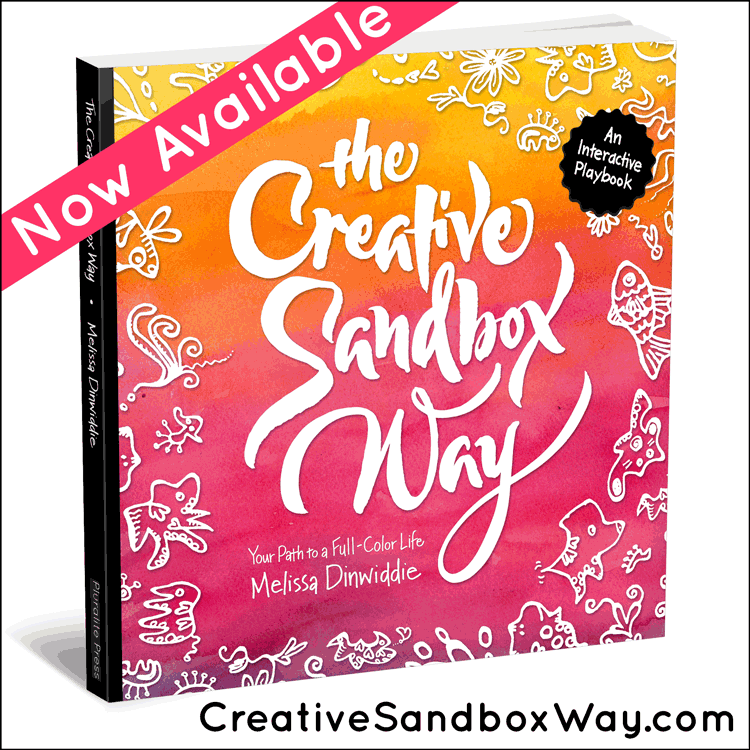
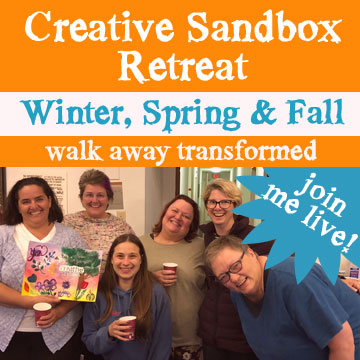
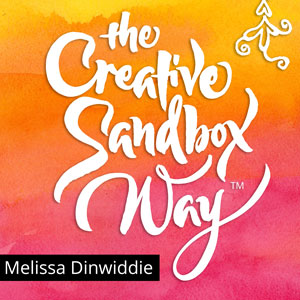

Thank you!!! Super!
You’re welcome, Susie! I’m glad you liked it.